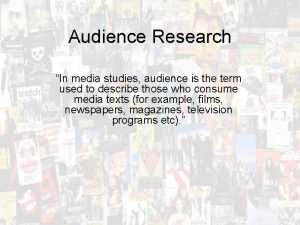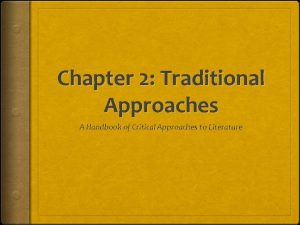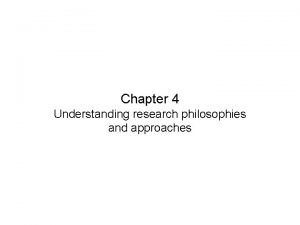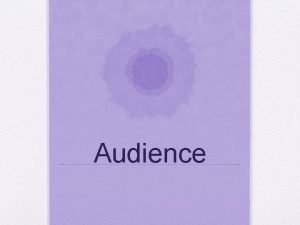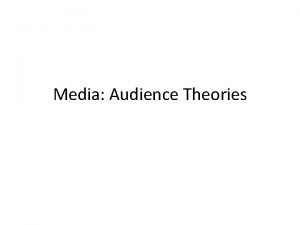Critical Approaches to Media Quantitative Audience Research Quantitative

















- Slides: 17

Critical Approaches to Media

Quantitative Audience Research Quantitative research is a method of gathering data about numbers and statistics related to the product. • Using quantitative methods can measure the quantity of many things e. g. how many people live in a village, how many people own products produced by Apple etc. • Quantitative research can prove/disprove any assumptions that is given about the audience. • Examples of organizations that carry out this method of research are – BARB, RAJAR and ABC

Qualitative Audience Research Qualitative research is a method of gathering data about the interests/opinions of the audience. • Qualitative research can show the problems and help the development for quantitative research. – e. g. Film and game reviews, these are very important as the feedback allows success or failure of the product and can cause mixed reviews to different target audiences. • Qualitative data is gathered through techniques such as surveys or face-toface/Individual interviews and focus groups. • Organisations that gather this information, carry out a “focus group” which are made up of people from different backgrounds.

Audience Profiling There are various categories to consider when carrying out different methods of research to audiences. Here are the numerous categories as follows: • Economic • Social • Ethnological • Political • Gender Audiences are often segmented into different groups based on certain criteria: • Geographic Segmentation – Divides audiences based around physical and political boundaries. • Demographic Segmentation – Divides audiences based around age, race, religion, gender, family size, ethnicity, income, and education. • Psychographic Segmentation – Divides audiences based on their lifestyles such as attitude, expectations and activities. • Behavioural Segmentation – Divides audiences based on their behaviour such as how they respond to, use or know of a product.

Research Organisations Examples of organisations that conduct audience research are – BARB, RAJAR and ABC. • BARB collects data on what people watch/view on television. • RAJAR collects data on what people listen to on the radio. • ABC collects data on what people read in newspapers and online.

BARB (Broadcasters’ Audience Research Board) • BARB was established in 1981 • Delivers the official viewing figures for UK television audiences • Commissions research companies to collect data that represent the viewing behaviour of the UK’s 26 million TV households. • This data offers broadcasters and advertisers vital information that shows how programmes, channels or advertising campaigns have performed.

BARB Research Methods • Television is the only medium that a fully representative in the measurement. • BARBs panel is a sample of very carefully recruited households, these households represent households across the nation. • BARB interviews over a 1000 families every week for the BARB establishment survey. Information needed to accurately weight their viewing data so it is representative of the whole nation. • Then 5100 homes are selected by household type, demographic, TV platforms and geography. Over 12000 people living in these homes which then give an accurate representation of the country.

ABC (Audit Bureau of Circulations) • ABC is the industry body for media measurement for print (e. g. newspapers, magazines) and online publications. • ABC gathers data information about what people read about online and in print. • • • Their data is used by a wide range of decision makers: Media owners Media agencies Advertisers Rights owners Investors Management

ABC Research Methods • A team of experts verify data across a wide range of media channels including print, online and events and look to include new platforms as they emerge. • They take a census-based approach which means counting every interaction rather than using a survey sample. • This allows ABC to provide granular detail across channels to showcase performance and support the media buying process which is all the more important in our increasingly fragmented world.

RAJAR (Radio Joint Audience Research) • • RAJAR collects data about what radio stations people listen to. Established in 1992 RAJAR is the official body in charge of measuring radio audiences in the UK. RAJAR is owned by the BBC and the Radio Centre on behalf of the commercial sector. RAJAR is responsible for setting the research specification for overall quality control.

RAJAR Research Methods Data Collection • Information is collected during a seven day self-completion diary. Diaries are personally placed with one selected adult (15+) and up to two children aged 10 -14 years (according to the number of children present) in each selected household. • The paper diary is customised at placement. Each respondent is asked to sort through a set of cards with the names of all the radio stations in the area and invited to select all the stations which they might listen to or hear in various situations. This process provides a station repertoire for the selected individual which is then entered in the diary by the interviewer, using station name labels. All paper diaries are collected personally by interviewers at the end of the seven days. • The online diary station selection is carried out by the respondent, each person is asked to look through a set of station names onscreen that are available in the area and invited to select all the stations which they might listen to or hear in various situations.

Product Study

Quantitative Data/Audience Profile Primary: • Women aged 24+ fans of the novel or aware of the novel • Women aged 30+, ABC 1’s, medium-heavy cinema goers • Time-poor, busy women (working/mothers) read supplement magazines and Kindle, meet their friends regularly Secondary: Male and Female, ABC 1’s, regular cinema goers, fans of quality drama and independent Tertiary/ How the film appeals to different audiences: • Fans of Tilda Swinton – Mixture of Male and Female. • Fans of Lynne Ramasy – Majority female audience. • Fans of Ezra Miller – Younger generation mainly females. • Students and Film Students – Both Male and Females.

Target Audience - Demographics For this film, there was no-one under the age of 15 who went to see this film. However, only 8% of 15 -24 year olds went to see 'We need to talk about Kevin'. In comparison to an older audience, 57% of 45+ year olds went to see the film, this maybe because they can relate to the loss of a child, but also because the film is quite emotional and this is the complete opposite to a film which focuses more on the action rather than the character.

Quantitative Data Box Office Income Box Office Gross Income - $9. 2 million United Kingdown – Opening Weekend: $785, 526 Total Gross Income (UK): $3, 518, 623

Qualitative Data Website – Rotten Tomatoes The website rottentomatoes. com gives audience the option to share their own personal opinions on films. The audience can write a review or like/dislike the film by clicking a button. 33, 661 users gave their opinion. 78% of people worldwide liked the film whilst 22% of others used the disliked button. Overall, 187 reviews were counted amongst the hundreds of people who viewed the film “We need to talk about Kevin”. 76% people’s likes were counted, whilst they reviewed why they may/may have not liked the film

Qualitative Data Rotten Tomatoes • In the Top critics overall review of “We need to talk about Kevin” was rated 76%, either giving like or dislike. • These reviews from critics can be taken from newspapers and magazines. It will also link the source where the critic review is taken from.
 Critical semi critical and non critical instruments
Critical semi critical and non critical instruments Spaulding classification system
Spaulding classification system What is audience research in media
What is audience research in media Examples of audience research in media
Examples of audience research in media Invoked audience
Invoked audience Nnn poem
Nnn poem Literary criticism approaches
Literary criticism approaches Formalistic approach in literature
Formalistic approach in literature A handbook of critical approaches to literature
A handbook of critical approaches to literature What is a critical lens
What is a critical lens Outline critical approaches to interpreting text
Outline critical approaches to interpreting text Applying critical approaches to literary analysis
Applying critical approaches to literary analysis Slidetodoc.com
Slidetodoc.com Marketing research approaches to demand estimation
Marketing research approaches to demand estimation What is research
What is research Experimental research design types
Experimental research design types Research philosophies and approaches
Research philosophies and approaches Types of audience in mass communication
Types of audience in mass communication


